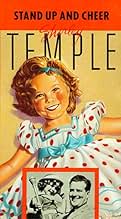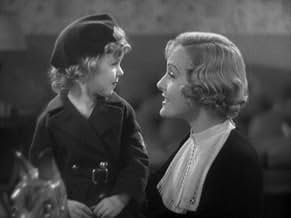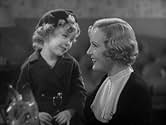Adicionar um enredo no seu idiomaA little girl's (Shirley Temple) toe-tapping musical numbers uplift the nation during the Depression in this charming classic that includes Temple's rendition of "Baby Take a Bow.A little girl's (Shirley Temple) toe-tapping musical numbers uplift the nation during the Depression in this charming classic that includes Temple's rendition of "Baby Take a Bow.A little girl's (Shirley Temple) toe-tapping musical numbers uplift the nation during the Depression in this charming classic that includes Temple's rendition of "Baby Take a Bow.
- Direção
- Roteiristas
- Artistas
- Prêmios
- 2 vitórias no total
- Aunt Jemima
- (as 'Aunt Jemima')
- Senator Danforth
- (as Mitchell)
- Senator Short
- (as Durant)
- Nick Foran
- (as Nick Foran)
- Hill-Billy
- (as 'Skins' Miller)
- Dancer
- (não creditado)
- Dancer
- (não creditado)
Avaliações em destaque
It is always vital when examining old films to try to be sensitive to their context within their own time frames. Important movies of 70 years ago may look terribly trite now through absolutely no fault of their own. Judging by today's standards can often lead to pitfalls.
That having been stated, however, it is difficult to appreciate this film without seeing it for what it is: undeniably silly. And racist. And even a bit bizarre at times. But it contains one great jewel...
Earnest Warner Baxter & lovely Madge Evans certainly give the plot a try, but the script is dead set against them all the way, making him encourage hillbilly singers as the remedy for the nation's economic woes and having her mope about lovelorn & lonely.
As Aunt Jemima, blackfaced singer Tess Gardella (very popular at the time on Broadway's Show Boat) and especially Stepin Fetchit are embarrassingly stereotyped. It should be noted, however, that this sort of racial belittlement was not unusual in the Hollywood of the 1930's.
The physical, knockdown humor of Frank Mitchell & Jack Durant, playing a couple of zany U. S. Senators, is very odd & no longer funny. Odder still is the penguin that thinks he's Jimmy Durante.
Familiar faces show up from time to time - Nigel Bruce, Ralph Morgan, little Our Gang kid Scotty Beckett, warbling John Boles - but they are quickly submerged by the plot.
In the midst of all this clutter of mismatched parts, when all might be given up for lost, comes five-year-old Shirley Temple and she is an utter joy.
Shirley had already appeared in a series of features & shorts. But it was here, singing & dancing - and completely obliterating poor James Dunn who played her father - that the situation was ripe for her to march straight into the nation's heart. In 1935 Shirley would begin to star in her string of classic family films, and, with the death of Marie Dressler in July of 1934, the mighty moppet was to begin her reign as Hollywood's number one box office attraction.
So, with the arrival of Shirley Temple, we do indeed have much for which to STAND UP AND CHEER!
Take, for example, the show-stopping finale to "I'm Laughing," performed by Tess Gardella. There are a series of tableaux in this number, of various individuals all representing different marginalized groups: Immigrants, sweatshop workers, laborers of all kinds, all leading up to Tess Gardella herself busting out with the biggest, cheeriest performance of all, surrounded by a rousing, dancing chorus. It was clearly meant to recap the song's theme--if I can laugh, as downtrodden as I am, so can you--and to embody those who persevere and triumph over circumstance. With a swish of her ample hips and a gleam in her eye, Ms. Gardella triumphs.
The standard Stepin Fetchit routine has been analyzed everywhere, but let me just add that in this picture, the actor personifies African American resistance. In 1934 Black men were still not free from the vicious system of racial etiquette known as Jim Crow, and were therefore limited in the number of personae they were allowed to display. The genius of Stepin Fetchit is that he acts out the prescribed social role while frustrating those who prescribe it by withholding his intelligence and personality from the social interaction altogether. He slyly gives white people exactly what they demand,nothing more, forcing them to realize that perhaps that's not what they want after all. The resistance is his and the joke is on them.
An enjoyable Depression musical which reflects upon the people and the times, is noted virtually as a Shirley Temple movie. With Baxter and Evans enjoying more screen time, Temple, with her limitations to the plot, became an overnight sensation playing little Shirley Dugan, daughter to song and dance man, Jimmy Dugan (James Dunn). The musical numbers in STAND UP AND CHEER do not play for the audiences in the movie (there are none), but mainly to its viewers. The song and dance appears during the course of the story, beginning with Dick (billed Nick) Foran coming out of a front page newspaper as Baxter and Evans read the headlines, and singing "I'm Laughing," later sung by a cross-country of citizens, and concluding with Aunt Jemima (Tess Gardella) and chorus. Next comes "Baby, Take a Bow" performed by Dunn, a chorine, and Temple; "Broadway's Gone Hillbilly" (sung by Sylvia Froos and chorus); "She's Way Up Thar" (sung by John "Skins" Miller); "This Is Our Last Night Together" (an audition number, sung by John Boles and Sylvia Froos); and the big parade march of happy Americans singing "We're Out of the Red" (introduced by Foran as the Paul Revere bearer of good news on a horse riding across the sky).
As many classic movies in recent years have been nearly restored to its original length, such as the 1933 classic, KING KONG, for example, STAND UP AND CHEER seems to have never played in its entirety on television since the 1960s, and currently is the victim of further butchery. While the Stepin Fetchit segment, in which he encounters a penguin dressed, acting and talking like Jimmy Durante, has been restored, other scenes have been deleted, making the print in circulation since 1984 choppy and confusing. There's one scene in the story in which Baxter says "No" to Fetchit before hearing what he has to say. The violent gags of comedy team of Mitchell and Durant as U.S. senators are either trimmed or completely cut out. I was fortunate to have watched the complete version of STAND UP AND CHEER at a revival theater in New York City in the 1980s. Scenes missing from current prints are Aunt Jemima's introduction to "I'm Laughing," and Nick Foran's introduction to the finale, "We're Out of the Red." 'Skins' Miller, billed as the hillbilly, seen looking for a gal named Sally, bursting into song, "She's Way Up Thar," while Fetchit is out in the mountains with a butterfly net hired to get a hillbilly by Dinwiddie (Nigel Bruce), is completely gone. The closing cast credits is shown on screen in freeze frame and ends abruptly. Originally presented in theaters at 80 minutes, it can now be seen on video cassette (sometimes colorized) and on TV at the 69 minute length. A pity, because those seeing this for the first time today will think this is how it was presented to 1934 audiences, and it wasn't.
STAND UP AND CHEER, which formerly played on American Movie Classics from 1996 to 2001, can be seen once in a while on the Fox Movie Channel. While no great masterpiece, this is one movie that deserves restoration to its original 80 minute length to be fully appreciated. (**1/2)
Well maybe that story got back to the ears of Will Rogers because he was the one who came up with the idea of a Cabinet position for Secretary of Amusement. Maybe Rogers had himself in mind for the job, he was sure doing it unofficially.
Fox was Rogers's home studio, but he makes no appearance here. Instead the president of the United States hires Warner Baxter for that job.
Baxter essentially reprises his role of Julian Marsh the driven director from 42nd Street. I guess the money from that hit show didn't last long for Baxter so he's got this job.
But can you imagine; instead of trying to get financial backers for a show, Baxter goes before a Congressional committee for an appropriation? I'm not sure which is a worse ordeal.
So the movie is Baxter trying to find a talent enough for a big extravaganza that will do what Herbert Hoover wanted from only one song.
Stand Up and Cheer survives today because of the appearance of Shirley Temple, on her way to becoming the movies' biggest box office attraction of the decade. She only does one number here, with hoofer James Dunn as her father. But it's one of her biggest, Baby Take a Bow.
If it weren't for Shirley, the film would have been a curious forgotten relic of some very tough times. Still it's worth watching for more than just Shirley Temple.
Temple and James Dunn are really the only bright spots in this production. Their on screen rapport is magic, and contrary to what others have stated, they BOTH hold their own during their crowd pleasing number "Baby, Take a Bow," in my opinion.
Truly a product of it's day. It's widely reported that this film brought smiles to the faces of many, and try as I may to ignore it's racial stereotypes, and bland dialogue, somehow the whole thing doesn't work.
But, as I have already mentioned, Jimmy and Shirley are pure magic.
Você sabia?
- CuriosidadesFor the "Baby, Take a Bow" number with James Dunn, the studio felt it would be easier for Shirley Temple to do the dance she had done at her audition rather than learn a new one, so Temple spent her first day on the set giving Dunn dancing lessons.
- Citações
Lawrence Cromwell: Now, Miss Monroe...
Mary Adams: Er, Adams.
Lawrence Cromwell: Oh, yes, step here a minute, will you, please... something I want to show you. There's one phase in this amusement campaign which I think you ought to understand. The zones in...
[overcome by her good looks, he stops]
Lawrence Cromwell: You're beautiful.
Mary Adams: Ah, of course I'm not.
Lawrence Cromwell: What's that?
Mary Adams: I said I'm not beautiful.
Lawrence Cromwell: Young woman, you're talking to Lawrence Cromwell... Lawrence Cromwell, the world's recognized authority on feminine beauty and charm. Do you mean to stand there and question my judgment on the subject of beauty? Do you? Do you?
Mary Adams: Oh, no, no, I wasn't...
Lawrence Cromwell: Oh, but you DID question it. Now, you listen to me: when Lawrence Cromwell says a girl's beautiful, she's BEAUTIFUL, do you understand? Ha, the very idea! I demand an apology. Your personality definitely puts you in Class 10-A, Department B, with a double-X rating in my card index system. And, my system is the pre-eminent beauty catalogue of today.
[sizing her up at a glance]
Lawrence Cromwell: Height, 5 foot 4... weight, 116... bust, 34... waist, 26... hips, 36... calf, 12 and 1/2... ankle, 7. Questioning my judgement! Ha, ha, that is good.
Mary Adams: I'm really awfully sorry, Mr. Cromwell.
Lawrence Cromwell: Never mind, never mind, just... just let it be a lesson to you.
- Versões alternativasDifferent versions of this film exist, with various running times between 68 and 81 minutes. Some prints have deleted demeaning & outdated cultural depictions of African Americans that are offensive to modern audiences, including scenes with _Stepin Fetchit_ and _Tess Gardella_ in blackface as "Aunt Jemima".
- Trilhas sonorasStand Up And Cheer!
(1934) (uncredited)
Lyrics and Music by Lew Brown and Harry Akst
Sung by over the end credits
Instrumental over the title sequence and beginning credits
c. 1934 Movietone Music Corportation
Principais escolhas
- How long is Stand Up and Cheer!?Fornecido pela Alexa
Detalhes
- Tempo de duração1 hora 8 minutos
- Cor
- Proporção
- 1.37 : 1
Contribua para esta página




































